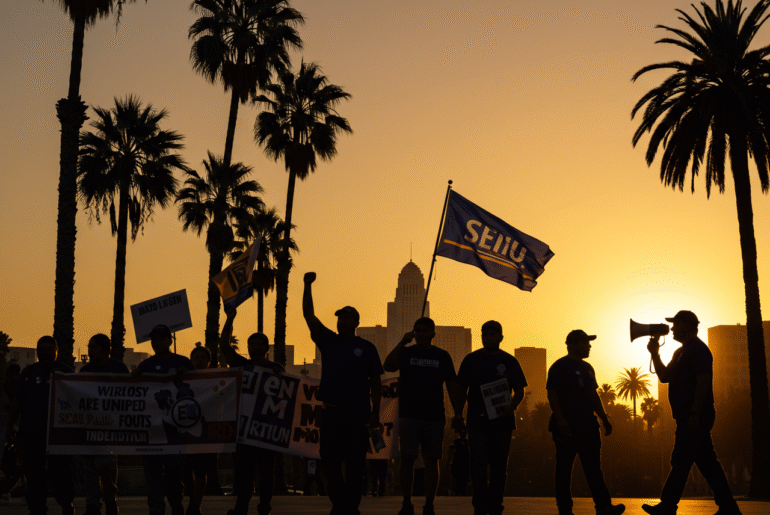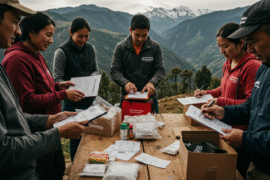This article may contain references to products or services from one or more of our advertisers or partners. We may receive compensation when you click on links to those products or services. Nonetheless, our opinions are our own.
The information presented in this article is accurate to the best of our knowledge at the time of publication. However, information is subject to change, and no guarantees are made about the continued accuracy or completeness of this content after its publication date.
Los Angeles is noted for its palm-lined boulevards, sunny beaches, and arts scene. There is a significant story behind the images of Hollywood glamour and taco trucks: the collaboration between labor unions and immigrant communities that altered the city’s social and economic landscape in the 2000s. Many people gathered in the streets in 2006 to protest against strict immigration laws. They did this to oppose the laws and to stand up for their rights and dignity. Labor unions played a significant role in this movement. They had long fought for fair treatment and justice at work, which was closely related to the struggles of immigrants. The groups coming together created a moment that would have a lasting impact on labor relations, immigration policy, and social justice movements all over the United States. Understanding how these forces worked together gives us important information about the power, solidarity, and hope that still exist today.
- How Immigration Shaped Labor in Los Angeles
- The Impact of Labor Unions on Worker Solidarity
- Cultural Identity as a Source of Solidarity
- What the 2006 Protests Meant for Workers and Immigrants
- How Conflict Shaped Collective Progress
- The Lasting Legacy of Labor-Immigrant Alliances
- Conclusion
- Frequently Asked Questions
- What triggered the 2006 immigration protests in Los Angeles?
- How did labor unions support immigrant communities during the protests?
- What were the messages of the protests?
- What challenges did labor unions face while supporting immigrants?
- How have labor unions adapted since the 2006 protests?
- Why do immigrant and labor issues remain connected today?
- How did the alliance between unions and immigrants influence labor organizing nationally?
- Recommended Reads
How Immigration Shaped Labor in Los Angeles
Immigration has played a significant role in American society and has influenced various stages of the country’s development. Immigrants have always brought work and new ideas to the US while looking for jobs. From the waves of people coming to Ellis Island to the Mexican workers who harvest California’s fertile fields, immigrants have always helped the country. By the early 21st century, Los Angeles had become a major hub for immigrants from Latin America, Asia, and other places. Many of these people found work in low-paying, labor-intensive fields. But these workers often had to deal with bad working conditions, no job security, and few protections. Labor unions saw how vulnerable immigrant workers were and started working to give them more power and fight for fair treatment. This help was important in bringing together different groups and getting ready for a big mobilization.
The Impact of Labor Unions on Worker Solidarity
Labor unions in Los Angeles possess a storied history of advocating for fair wages, safe working conditions, and workers’ rights dating back to the early 20th century. Their mission became especially critical in the late 20th and early 21st centuries as waves of immigrants filled low-wage jobs in sectors such as hospitality, construction, agriculture, and domestic work. Factors that made unions essential allies included:
- Collective Bargaining Power: Unions enabled workers to negotiate better wages, benefits, and working conditions collectively.
- Legal and Political Expertise: Unions offered access to legal resources and advocacy networks.
- Cultural Competence: Many unions created Spanish-language and multilingual resources, respecting members’ cultural backgrounds and removing language barriers.
- Community Support: Beyond labor issues, unions helped immigrants navigate healthcare, housing, and immigration paperwork.
Cultural Identity as a Source of Solidarity
Immigrants often arrived in Los Angeles searching not only for work but also for community. Labor unions recognized that cultural identity was inseparable from the immigrant experience and responded by fostering inclusive spaces celebrating members’ backgrounds. During the 2006 protests, this cultural solidarity was displayed through
- Banners and flags representing diverse countries.
- Chants in multiple languages.
- Traditional music and performances reflecting the participants’ heritage.
These vibrant elements transformed political demonstrations into celebrations of identity, helping unify diverse immigrant groups under shared goals of justice and dignity.
Voted "Best Overall Budgeting App" by Forbes and WSJ
Monarch Money helps you budget, track spending, set goals, and plan your financial future—all in one app.
Get 50% OFF your first year with code MONARCHVIP
What the 2006 Protests Meant for Workers and Immigrants
In 2006, the proposed H.R. 4437 legislation threatened to criminalize undocumented immigrants and those who assisted them. Los Angeles became the epicenter of resistance, with an estimated one million people joining protests. Labor unions played critical roles by:
- Organizing marches with coordinated logistics and security.
- Providing legal and financial resources for demonstrators.
- Amplifying immigrant voices in the media.
- Building relationships with lawmakers to advocate for humane immigration policies.
The protests demonstrated the strength of alliances between workers and immigrant communities, emphasizing that labor rights and immigrant rights are inherently linked.
Labor Unions and their Importance
| Factor | Impact on Protests |
|---|---|
| Resource Mobilization | Coordinated marches, transportation, outreach, and community support. |
| Political Connections | Engaged with lawmakers to advocate for immigration reforms and fair labor practices. |
| Unified Messaging | Framed immigrant rights as workers’ rights, creating a cohesive narrative. |
| Cultural Inclusivity | Ensured diverse groups felt seen and heard, fostering solidarity across ethnic and linguistic lines. |
How Conflict Shaped Collective Progress
Despite their successes, unions and immigrant communities encountered obstacles such as
- Cultural Misunderstandings: Varied traditions and norms occasionally led to friction.
- Language Barriers: Not all union leaders or members were equipped to communicate effectively across languages.
- Political Pushback: Some political figures and factions resisted unions’ involvement in immigration issues.
Yet, these challenges became catalysts for growth. Unions introduced cultural competency training, hired bilingual staff, and developed leadership programs for immigrant members, ensuring their concerns and aspirations were integrated into union strategies.
The Lasting Legacy of Labor-Immigrant Alliances
The 2006 protests established enduring connections between labor unions and immigrant communities, influencing labor organizing and advocacy nationwide. Their impact continues today as unions support immigrant rights campaigns, push for inclusive labor policies, and expand efforts to address intersecting issues like climate justice and digital workplace transformations.
Conclusion
The partnership between immigrant communities and labor unions in Los Angeles has changed the way people talk about immigration and workers’ rights in the whole country, not just in the city. These movements have shown how strong solidarity can be in fighting injustice and bringing about social change, from the protests in 2006 to the advocacy work going on now. Unions have helped change what it means to fight for dignity and fairness in America by seeing immigrants as important members of the workforce and society. This partnership is always changing, and it shows how to build inclusive coalitions that celebrate differences and make progress in all areas of life, including social, economic, and political ones. These alliances promise a future where every worker, no matter where they come from, can live a life of opportunity and respect. This is especially important as new waves of migrants arrive and job markets change.
Frequently Asked Questions
What triggered the 2006 immigration protests in Los Angeles?
The proposed H.R. 4437 legislation, which aimed to criminalize undocumented immigrants and penalize anyone assisting them, sparked widespread outrage and protests involving up to a million people in Los Angeles.
How did labor unions support immigrant communities during the protests?
Labor unions organized logistics, coordinated transportation, provided legal aid, mobilized members, and worked to amplify the voices of immigrant communities in both the media and political spheres.
What were the messages of the protests?
Protesters demanded comprehensive immigration reform, an end to the criminalization of undocumented immigrants, and recognition of the vital economic and social contributions of immigrant workers.
What challenges did labor unions face while supporting immigrants?
Challenges included cultural misunderstandings, language barriers, and political backlash from opponents who viewed union support for immigration reform as controversial.
How have labor unions adapted since the 2006 protests?
Unions have expanded bilingual services, implemented cultural competency training, and developed leadership opportunities for immigrants to ensure more equitable representation within their organizations.
Why do immigrant and labor issues remain connected today?
Immigrant workers continue to make up a significant portion of the low-wage workforce, often facing exploitation. Labor unions play a critical role in advocating for fair treatment and ensuring all workers, regardless of status, have access to rights and protections.
How did the alliance between unions and immigrants influence labor organizing nationally?
The success in Los Angeles inspired similar collaborations in other cities, demonstrating the effectiveness of uniting labor rights with immigrant rights to create powerful, inclusive movements.

Reviewed and edited by Albert Fang.
See a typo or want to suggest an edit/revision to the content? Use the contact us form to provide feedback.
At FangWallet, we value editorial integrity and open collaboration in curating quality content for readers to enjoy. Much appreciated for the assist.
Did you like our article and find it insightful? We encourage sharing the article link with family and friends to benefit as well - better yet, sharing on social media. Thank you for the support! 🍉
Article Title: How Labor Unions Shaped L.A. Immigration Protests
https://fangwallet.com/2025/07/07/how-labor-unions-shaped-l-a-immigration-protests/The FangWallet Promise
FangWallet is an editorially independent resource - founded on breaking down challenging financial concepts for anyone to understand since 2014. While we adhere to editorial integrity, note that this post may contain references to products from our partners.
The FangWallet promise is always to have your best interest in mind and be transparent and honest about the financial picture.
Become an Insider

Subscribe to get a free daily budget planner printable to help get your money on track!
Make passive money the right way. No spam.
Editorial Disclaimer: The editorial content on this page is not provided by any of the companies mentioned. The opinions expressed here are the author's alone.
The content of this website is for informational purposes only and does not represent investment advice, or an offer or solicitation to buy or sell any security, investment, or product. Investors are encouraged to do their own due diligence, and, if necessary, consult professional advising before making any investment decisions. Investing involves a high degree of risk, and financial losses may occur including the potential loss of principal.
Source Citation References:
+ Inspo
UCLA Labor Center. (2022, January 27). Taking freedom: Organizing lessons from the immigrant rights movement. University of California, Los Angeles.












































